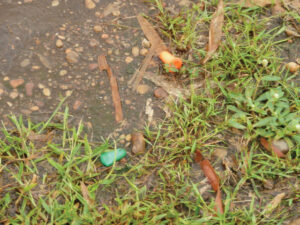- 800.525.2690
- [email protected]
- Mon - Fri: 8:00 - 4:30
Is There a Negative Impact of Disposable Earplugs?
Reports of environmental pollution by foam disposable earplugs increase each year. While there is definitely a place for these hearing protection devices, it is not all over the ground.

By Garry Gordon, MS and Robert M. Traynor, Ed.D., MBA, F-NAP
For many people, hearing protection is an important part of their daily routine. Whether the noise exposure is occupational, recreational or non-industrial, the risks of not wearing hearing protection are well documented. Failure to block out excessive noise levels can cause irreversible hearing damage, which can have serious implications on an individual’s personal and professional life and it is totally preventable!

There are various types of hearing protection available, from pre-formed flanged reusable to custom fit earplugs, however, the single-use disposable foam (PVC) or polyurethane (PU) earplug remains the most common type of hearing protection in use today, being commercially introduced over 40 years ago.
These earplugs consist of soft moldable foam that conform to the size and shape of the ear canal. When inserted correctly these earplugs may offer noise reduction ratings as high as 35 dB. For a correct fit, these foam type plugs are simply rolled into a tightly compressed cylinder and inserted inside the ear in a way that the plug conforms to the unique shape of the ear canal. For recreation, these foam plugs cost only a few cents per pair and are popular as they are easy to carry and offer utility in their protection against loud noise.
These inexpensive earplugs are widely used in industry. As part of controlled hearing conservation programs, manufacturers enforce the use and proper disposal of these earplugs in trash receptacles.
On the personal/recreational side, high noise levels from table saws, lawn mowers, motorcycles, the shooting range, racetracks or music festivals add exponentially to hearing hazards. The prudent choice made by more and more people is to protect the ear from damage and not become a premature hearing-impaired individual. Thus, as noise has increased in our environment, the public has become more aware of the hazards of loud noise, therefore the demand for and use of various types and styles of ear protection has increased.
Each year E.A.R. Inc. engages with numerous industrial and recreational hearing protection accounts worldwide. While they all agree that foam disposable hearing protection devices (HPDs) provide excellent hearing protection, reports of environmental pollution by these devices increase each year. Safety officers, HPD users, occupational hearing conservationists, industrial hygienists and others all agree that there is definitely a place for these foam HPDs, but it is not all over the ground. Unfortunately, unlike in industry, there are no controls for proper disposal of earplugs except for warnings of the repercussions from littering.

Unfortunately, unlike in industry, there are no controls for proper disposal of earplugs except for warnings of the repercussions from littering.
These plugs show up on the floor at gas stations, various types of manufacturing plants, shooting ranges and even airports. The U.S. Air force has also had difficulty with foam plugs littering the flight lines endangering jet engines and other expensive equipment. From their name, disposable earplugs are those that you wear once then dispose of them. Since they are disposable, they are cheap and may be easily replaced.
The litter problem also includes pre-formed reusable earplugs. From their name, reusable pre-formed earplugs are designed in various sizes to fit different sizes of ear canals and may be used more than once. They are a popular alternative used by musicians, festival goers, hunters, construction workers or anyone who is frequently in a noisy environment. They are pre-formed for the ear canal and can be washed so that bacteria is not reintroduced into the ear. The pre-formed earplugs have a useable life and therefore become disposable when they have discolored or begin to harden.
The bottom line is that literally millions of disposable earplugs and their wrappings are disposed of each day. Unfortunately, there are not any guidelines as to disposal. They can only go in with regular garbage. They are not biodegradable; nor are they recyclable, however, everyone can do their part in keeping our streets and neighborhoods clean of earplug litter by disposing of them in the proper receptacle. Or another alternative may be to obtain a good set of custom hearing protection devices that have a long-term lifecycle which would avoid the trash can altogether. WMHS
This article was originally published on workplacepub.com.
Robert M. Traynor, Ed.D., MBA, FNAP is an Adjunct Professor of Audiology at the University of Arkansas for Medical Sciences and Salus University and a Fellow of the National Academies of Practice. He also consults and does forensic audiology (https://roberttraynor.com).
Garry Gordon, MS, is the CEO/Owner and Audiologist/Instructor at E.A.R Inc. Gordon has served well over 4,000 major medical, audiological and industrial accounts and trained a network of 500+ recreational and industrial providers who market high-quality hearing protection (https://earinc.com).
